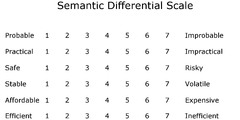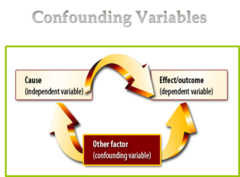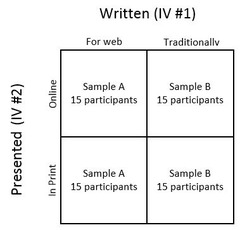Research Methods study guide
Unlock all answers in this set
Unlock answersquestion
Applied research
answer
Conducted to address issues in which there are practical problems and potential solutions.
question
Authority
answer
1. Reliable or trustworthy sources 2. News media 3. Books 4. Government officials 5. Religious figures 6. Political pundits
question
Basic Research
answer
Attempts to answer fundamental questions about the nature of behavior
question
Empiricism
answer
Knowledge is based on observations. Data (observations) are collected that form the basis of conclusions about the nature of the world
question
Falsifiability
answer
Good scientific ideas are testable. Research can either support or falsify them
question
Intuition
answer
Relies on personal judgement. Example: this ad should persuade them to quit smoking.
question
Pseudoscience
answer
Definitely not a science. Hypotheses generated are not typically testable. Example: a pill that claims to improve memory...or increase weight loss. claims tend to be vague and ignore conflicting evidence
question
Discussion section
answer
Reviews the research from various perspectives. Compares with past results. Includes suggestions for practical applications and for future research on the topic. (strengths and weaknesses)
question
Introduction Section
answer
1. Outlines problems 2. Past research and theories 3. Formal hypotheses or specific expectations
question
Hypothesis
answer
It is a tentative statement about the relationship between two or more variables. It is a testable prediction about what you expect to happen in your study.
question
APA Ethics Code
answer
5 General Principles 1. Beneficence 2. Responsibility 3. Integrity 4. Justice 5. Respect for the rights and dignity of others
question
The Belmont Report
answer
Ethical Principles and Guidelines for the Protection of Human Subjects of Research
question
Justice (Belmont Report)
answer
Achieved through selection of persons
question
Beneficence (Belmont Report)
answer
Achieved through assessment of risks and benefits
question
Autonomy (Belmont Report)
answer
(Respect for persons) - achieved through informed consent
question
Debriefing
answer
Happens after the study. Tells them the purpose of study, anticipated results, practical implications.
question
Exempt Research
answer
Observations. No manipulation of the subject. Example: anonymous surveys, questionnaires, educational tests
question
Honest Experiments
answer
Participants are made aware of the purpose of the research and that they will be studied (e.g., speed dating studies; study skills improvement program)
question
Informed Consent
answer
The purpose is to provide potential participants with all information that might influence their decision about whether to participate
question
Minimal Risk Research
answer
When the risk of harm is no greater than risk encountered in daily life or routine physical or psychological tests. Example: physiological data, moderate exercise. Routine review conducted by the IRB
question
Confounding variable
answer
When an uncontrolled third variable is operating and is not wanted. Changes results of DV. Example: Activity level (IV) weight gain(DV) age (CV)
question
Construct validity
answer
Concerns whether our methods of studying variables are accurate. Example: Think about the bathroom scale—is this an accurate measure of weight?
question
Internal Validity
answer
is the extent to which you are able to say that no other variables except the one you're studying caused the result. For example, if we are studying the variable of pay and the result of hard work, we want to be able to say that no other reason (not personality, not motivation, not competition) causes the hard work. We want to say that pay and pay alone makes people like Sean work harder.
question
External Validity
answer
Concerns whether we can generalize findings of a study to other settings/places/populations.
question
Correlation coefficient
answer
The way of measuring the strength of the linear association between two variables. Ranges from r = -1.0 to +1.0 Closer to 1 (+ or -) = stronger relationship between variable
question
Curvilinear relationship
answer
As scores on one variable increase, scores on the second variable tend to increase, then decrease, (then increase)
question
Experimental Control
answer
All extraneous variables in an experiment are kept constant; so that it cannot be responsible for the results of a study—in other words, it cannot be the confounding variable. Experimental control is accomplished by treating participants in all groups in the experiment identically; the only difference between groups is the manipulated variable.
question
Experiment Method
answer
One variable is manipulated or controlled and the other is measured (REMEMBER: in the NONexperimental method, both variables are measured). Attempts to eliminate the influence of all potential third variables on the dependent variable
question
Field Experiment
answer
Researchers manipulate an IV in a natural setting, such as a parking lot or a mall. Example: researchers have studied people's parking behavior by driving a car in a variety of ways
question
Negative Linear Relationship
answer
Higher scores on one variable tend to predict lower scores on the other variable
question
Positive Linear Relationship
answer
Higher scores on one variable tend to predict higher scores on the other variable OR Lower scores on one variable tend to predict lower scores on the other variable
question
Non-experimental method (correlational method)
answer
Relies on observation or interactions to come to a conclusion. The non-experimental researcher must rely on correlations, surveys or case studies, and cannot demonstrate a true cause-and-effect relationship. Cannot manipulate variables. Both variables are measured.
question
Operational Variable
answer
The specific way in which a variable is measured in a particular study
question
Participant Variable
answer
The differing individual characteristics of participants in an experiment. Example: age, background, socioeconomic status, current mood.
question
Randomization
answer
The researcher can be confident that the characteristics of the participants in the two groups will be virtually identical.
question
Third Variable Problem
answer
There is danger that no direct causal relationship exists between the measured variables. X and Y appear to be related. But they do not influence each other. Instead, a third variable (T) causes both of them to change.
question
Concurrent Validity
answer
Examining the relationship between a measure and a behavior at the same time Example: studying a measure of shyness in a group of salespeople (probably not shy) and IT experts (probably shy) in the same company
question
Content Validity
answer
Compare measure with other content that defines the variable. Example: A measure of depression should have content that links to each of the symptoms that define depression
question
Convergent validity
answer
Extent to which scores on a measure are related to scores on other measures. Measures of similar constructs should converge. Example: One measure of shyness should correlate highly with another shyness measure or a measure of social anxiety
question
Cronbach's Alpha
answer
Correlation of each item on the measure all other items on the measure. Ranges from 0.00 (no reliability) to 1.00 (perfectly reliable). ? = .80 or greater indicates high reliability
question
Discriminant Validity
answer
Scores on a measure are not related to variables with which they should not be related. Measure should discriminate between the variable of interest and other unrelated constructs Example: Shyness and value of forcefulness with others should not be related
question
Face Validity
answer
whether or not your study measures what it is supposed to measure. You can think of it as where you just skim the surface in order to form an opinion.
question
Internal Consistency Reliability
answer
Extent to which raters agree in their observations. Single observation of one rater may be unreliable. Solution is to use multiple raters to observe the same behavior. Cohen's Kappa: Correlation between the observations of raters
question
Interval Scale
answer
Difference between numbers on the scale are meaningful. no absolute zero Example: thermometer
question
Item-Total Correlation
answer
The item total correlation is a correlation between the question score (e.g., 0 or 1 for multiple choice) and the overall assessment score (e.g., 67%)
question
Nominal Scale
answer
No quantitative information. categories.
question
Ordinal Scale
answer
Allow us to rank order the levels of the variable being studied. No particular value is attached to the l ls between numbers Example: Star ratings for movies
question
Pearson Product-Moment Correlation Coefficient
answer
Is a measure of the linear correlation between two variables X and Y, giving a value between +1 and ?1.
question
Predictive validity
answer
Using scores on one measure to predict future behaviors. Example: Validity of SAT test is demonstrated by its ability to predict performance in college
question
Ratio Scale
answer
Just like interval, an absolute zero indicates the absence of whats being measured. Example: weight
question
Reactivity
answer
Measure is reactive if awareness of being measured changes peoples' behavior. A reactive measure tells us how people behave when they know they are being measured, but not how they would behave under natural circumstances. is a phenomenon that occurs when individuals alter their performance or behavior due to the awareness that they are being observed.
question
Split-half reliability
answer
A measure of reliability in which a test is split into two parts and an individual's scores on both halves are compared.
question
Test-retest reliability
answer
Obtained by administering the same test twice over a period of time to a group of individuals. Example: if a group of students take a geography test just before the end of semester and one when they return to school at the beginning of the next, the tests should produce broadly the same results.
question
Closed-ended questions
answer
Limited number of response alternatives given. More structured. Response alternatives the same for everyone. Example: how much do you dislike or like this class?
question
Graphic Rating Scale
answer
A graphic rating scale is a commonly used scale system for performance appraisals. The scale typically features a Likert scale from 1-3, 1-5, and so on. An example of a 1-3 rating could include responses such as: 1: Poor, 2: Average, and 3: Excellent.
question
Open Ended Questions
answer
Respondents are free to answer any way they would like. Require time to categorize and code
question
Rating Scale

answer
Ask people to provide "how much" judgments on any number of dimensions Example: Amount of agreement, liking, or confidence
question
Semantic Differential Scale

answer
Respondents rate any concept (people, objects, behaviors, ideas) on a series of bipolar adjectives
question
Dillman's (2008) Principles
answer
1. Simplicity 2. Negative wording 3. No Loaded questions 4. No Double-barreled questions 5. Nay Yae questions
question
Attrition/Morality
answer
(dropout factor) Even if groups started the same, dropout may cause them to become different. Pretest allows us to assess whether dropout made groups different. Most likely in longitudinal studies
question
Between-subjects design (also independent groups design)
answer
Subjects participate in only one group - either experimental or control. Comparisons made between different groups of subjects. Random assignment.
question
Carryover Effect
answer
Possible that the effect of the first condition carries over and influences the response to the second condition
question
Confounding variable

answer
Another variable that occurs along with the independent variable . Is an uncontrolled variable. Cannot determine which variable is responsible for the effect. Good experimental design requires eliminating confounding variables
question
Fatigue effect
answer
Change of performance on second task due to tiredness, boredom, or distraction
question
Matched Pairs Design
answer
People are matched on a participant characteristic. Matched to either the dependent measure or a variable that is strongly related to the dependent variable Example: GPA, weight, diet.
question
Posttest-only design
answer
Obtain two equivalent groups of participants. Introduce the independent variable. Measure the effect of the independent variable on the dependent variable
question
Practice effect (also learning effect)
answer
Practice effects can be defined as influences on performance that arises from a practicing a task. Even after, participants have a tendency to perform initial trials poorly because they are still not warmed up to it
question
Pretest-posttest design
answer
Only difference: A pretest is given to each group prior to introduction of the experimental manipulation. Assures that groups are equivalent at the beginning of the experiment. Not usually necessary with random assignment to conditions
question
Repeated measures design (also within-subjects design)
answer
The same people participate in both conditions. Example: If you wanted 10 participants in each condition, you would need 10 participants total
question
Selection Differences
answer
The difference between the average value of a quantitative character in the whole population and the average value of those selected to reproduce the next generation Example: The selection differential is the difference of the base population mean and the mean of the selected parents. The selection response is how much gain you make when mating the selected parents.
question
Factorial Design
answer
Experiments with more than one IV (or factor). Simplest factorial design: 2 X 2 factorial design. Has two IVs, each IV has two levels. Example: "Gender" might be a factor with two levels "male" and "female" and "Diet" might be a factor with three levels "low", "medium" and "high" protein.
question
Interaction
answer
Exists when the effect of one IV on the DV depends on level of the other IV. Can't be obtained in simple experimental designs that only have two levels
question
Mixed Factorial Design

answer
involves two or more independent variables, of which at least one is a within-subjects (repeated measures) factor and at least one is a between-groups factor. In the simplest case, there will be one between-groups factor and one within-subjects factor.
question
Main Effect
answer
The effect of each IV taken by itself. In a design with 2 IVs, there are two main effects - one for each IV. Tells you about the overall relationship between an IV and the DV



